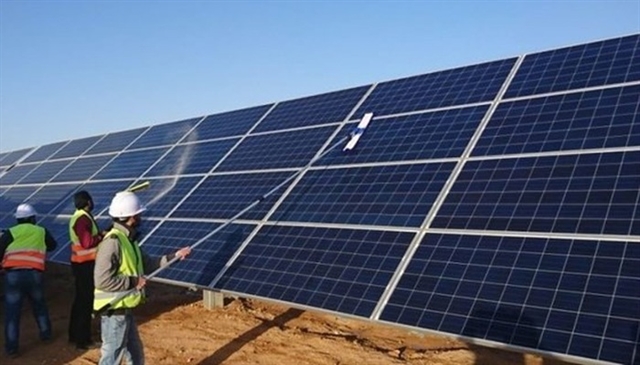 Economy
Economy


|
| Maintenance of solar panels of a solar power project. The MoIT has been compiling the draft on FiT for solar power projects in the period from July 1, 2017 until December 31, 2021. — Photo vneconomy.vn |
HÀ NỘI — Việt Nam Electricity (EVN) group has agreed with continuing the current feed-in tariff (FiT) rate at 9.35 US cents per kWh for rooftop solar power projects nationwide until 2021 as proposed by the Ministry of Industry and Trade (MoIT).
This is the EVN's feedback on the ministry's draft mechanism for encouraging the development of solar power projects in Việt Nam, including the FiT programme between July 1, 2019 and December 31, 2021 as required by the ministry.
At the draft, the MoIT said it is necessary to maintain this tariff at 9.35 US cents until the end of 2021 nationwide aims at encouraging the development of rooftop solar power projects.
This rate has been applying for all kinds of solar technologies, including floating solar power projects, ground-mounted solar power projects, rooftop solar power projects, under the FiT programme between June 1, 2017 and June 30, 2019.
EVN also said the State should not encourage investment in the development of solar power projects in areas with low solar irradiance and it needs to prioritise development of such projects in locations having high solar irradiance, reported vov.vn.
According to EVN, the promotion of solar power investment in the low solar irradiance regions should be considered later, taking into account payment ability of the final consumers.
Therefore, EVN has agreed with the irradiance zonal classification of provinces and cities into two different zones to calculate tariff rates.
In middle-June, the ministry submitted to the Government two plans on the tariffs with one based in the irradiance zonal classification of provinces and cities into two different zones and the other based on classification into four different zones that was submitted to the Government in May.
For the irradiance zonal classification of provinces and cities into two different zones, the FiT rates arrange from 6.67 to 7.89 US cents per kWh for a group of six provinces with high solar irradiance known as Zone 2, including Ninh Thuận, Bình Thuận, Khánh Hòa, Đắk Lắk, Gia Lai and Phú Yên.
The remaining 57 provinces and cities with lower solar irradiance known as Zone 1 will enjoy the tariff rates between 7.09 and 8.38 US cents depending on solar technologies.
Meanwhile, for the irradiance zonal classification into four different zones, there are significant differences in tariff rates.
In this calculation, the group of the six provinces mentioned above is known as Zone 4 with the lowest tariff rates, ranging from 6.67 to 7.89 US cents per kWh.
The tariff rates range from 9.2 to 10.87 US cents for Zone 1, including northern provinces with the least potential in solar irradiance; from 7.91 to 9.36 US cents per kWh for Zone 2; and from 7.09 to 8.72 US cents for Zone 3.
The ministry said setting the lowest tariffs in Zone 4 where the solar irradiance is highest will avoid a situation of concentrating solar power projects there because investment in transmission lines at those provinces does not keep up with investment in solar power projects. That makes completed projects unable to join to the national grid.
The wide-ranging tariffs for four different zones will encourage investors to develop solar power projects in the northern and central provinces while the irradiance zonal classification of provinces and cities into two different zones could not do so.
Thái Phụng Nê, former Minister of Energy and the Prime Minister's Envoy on power projects, said there was rapid development of solar power projects over past years with capacity of tens of thousands of megawatts of solar power, reported the Đầu tư (Investment) newspaper.
Those projects need many 500kV and 220kV substations to solve the transmission of electricity to the national grid.
However, the development of sub-stations does not catch up with the construction of solar power projects.
First of all, the State needs to have location planning for developing solar power projects and also planning on construction of transmission system, Nê said.
According to EVN, as of May 31, about 50 solar power plants have been put into operation with a total designed capacity of about 2,481MW. There are about 4,000 customers mounting solar panels on the rooftop with total capacity about 45MW. — VNS